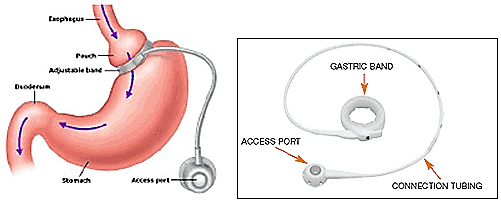What Your Doctor May Not Be Telling You About Lap band®
What is a Lap Band®?
The lap band is a silicone band that is placed around the upper part of the stomach.1 This band restricts the amount of food that enters the stomach. The mechanics are simple and consist of an inflatable gastric band, tubing, and an access port.
The FDA provides an example to explain how the lap band works.2

The access port shown above is used after surgery to contract or relax the tightness of the band. The port is sutured under the skin, on the abdominal wall. Your doctor will, using a small needle inject saline into the port. This will inflate and tighten the band, restricting how much food can pass through to the stomach.
Approximately 6-8 weeks after surgery, your doctor will begin the process to restrict the band. A monthly visit to your doctor is necessary to adjust the band, until the perfect size and appropriate restriction is felt by the patient when eating.
Is the Lap band covered by my existing health care plan?
Check with your provider. In some cases, your health care plan may provide coverage. Generally a lap band is indicated when patients are approximately 80 pounds overweight for women, or 100 pounds for men.3
A provider may use the FDA guidelines to determine eligibility. These guidelines state that the patient should have a Body Mass Index (BMI) of at least 40, or have a BMI of at least 35, with a weight-related health condition, such as: type two diabetes, high blood pressure (hypertension), or sleep apnea.
Your provider may require that you show proof of prior attempts at weight loss, or that you are suffering some other health complication due to your excess weight.
Is the Lap-Band Right for Me?
To answer this question fully a visit to your doctor is required. In addition to calculating your BMI, he will review your medical history, and verify that you are not overweight due to an underlying medical condition.
Getting a lap band alone is not going to solve your weight problem. You have to make a lifelong commitment to changing your eating habits. You will be required to visit your doctor monthly, and create a new eating plan. This plan must be strictly maintained for your lap band to perform.
Explore the information below to determine if this device is your best option.
Pros and Cons of Using a Lap-Band
The lap band is considered the least invasive of all surgical options for weight loss.
Lap band surgery is performed using a minimally invasive/laparoscopic technique, but is still considered major surgery. This technique allows a surgeon to make small incisions in the patient, inserting tubing, a viewing tube with a small camera (laparoscope), and tiny surgical instruments. The surgeon sees the organs on a monitor rather than through a large incision that would be normally be required. This procedure allows a quicker recovery time for patients.4
The average operating time to insert a lap band is only 40 minutes to 1 hour.5
According to the FDA, 80% of patients lost at least 30% of their excess weight and kept it off for a year.
Placement of a lap band is considered major surgery, and death can occur. An improperly installed band may require another surgery to correct the position of the band.6
You will be on a liquid diet for weeks after surgery.
Side effects include: heartburn, nausea, vomiting, and constipation.7
Once you have lost the weight you may have excess skin that will require more surgery to remove.
This is a lifelong commitment. Additional surgery is required to remove the device.
Let your Doctor know if you…
- Take aspirin on a regular basis
- Are addicted to drugs or alcohol
- Have disorders of the stomach or intestines
- Are under a treatment plan using steroids
- Are unwilling to change your existing diet
This list is not complete. You should discuss all existing medical conditions, any drugs, herbal remedies, or vitamins you are currently taking with your physician prior to surgery.
Learn everything you can about lap-bands before scheduling surgery.
Back to Articles
1 http://www.methodistsacramento.org/Medical_Services/Bariatric_Surgery/2123022 http://www.fda.gov/MedicalDevices/ProductsandMedicalProcedures/DeviceApprovalsandClearances/Recently-ApprovedDevices/ucm248133.htm
3 http://www.yourbariatricsurgeryguide.com/lap-banding/
4 http://www.surgery.usc.edu/divisions/tumor/pancreasdiseases/web%20pages/laparoscopic%20surgery/WHAT%20IS%20LAP%20SURGERY.html
http://articles.latimes.com/2010/apr/18/business/la-fi-hiltzik18-2010apr18
5 http://www.whybeobese.com/lap-band-weight-loss-surgery.html
6 http://www.accessdata.fda.gov/cdrh_docs/pdf/P000008S017c.pdf
7 http://www.costoflapband.com/the-basics-of-the-lap-band-system/

